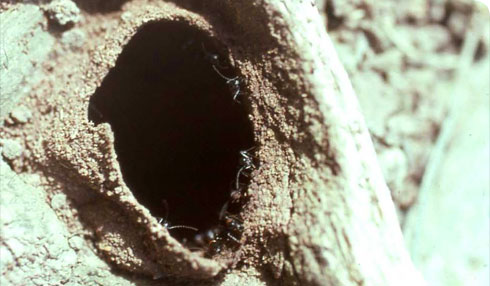Biology
All termites are social insects and live in colonies composed of three castes:
- soldiers
- workers
- reproductives
The workers:
- gather food
- build the nest
- care for the eggs and nymphs
- feed the other members of the colony
The soldiers defend the colony from attack, particularly by ants which are the main predators of termites.
The reproductives include:
- the queen, who lays all the eggs
- the king
- alates - termites that have wings and fly from the nest to found new colonies
Most termite soldiers have mandibles that they use for defence. However, soldiers of the Nasutitermitinae subfamily, such as Hospitalitermes, don’t have biting mandibles.
Over millions of years the mandibles have shrunk to short, non-functional points. Instead, they have evolved a 'nasus' (Latin for nose or snout) that is an elongated tube that projects forward from the front the head.
Much of the head capsule is filled with a large gland that connects to a small opening at the tip of the nasus. The gland contains a defensive chemical consisting mainly of sticky terpenoid compounds that act as a repellent. When threatened, the gland is squeezed and the chemical is squirted from the ‘gun’, shooting up to 3 or 4cm. The soldiers can thus repel ants from a distance, reducing the chances of the ants getting close enough to bite or carry the termite away.
